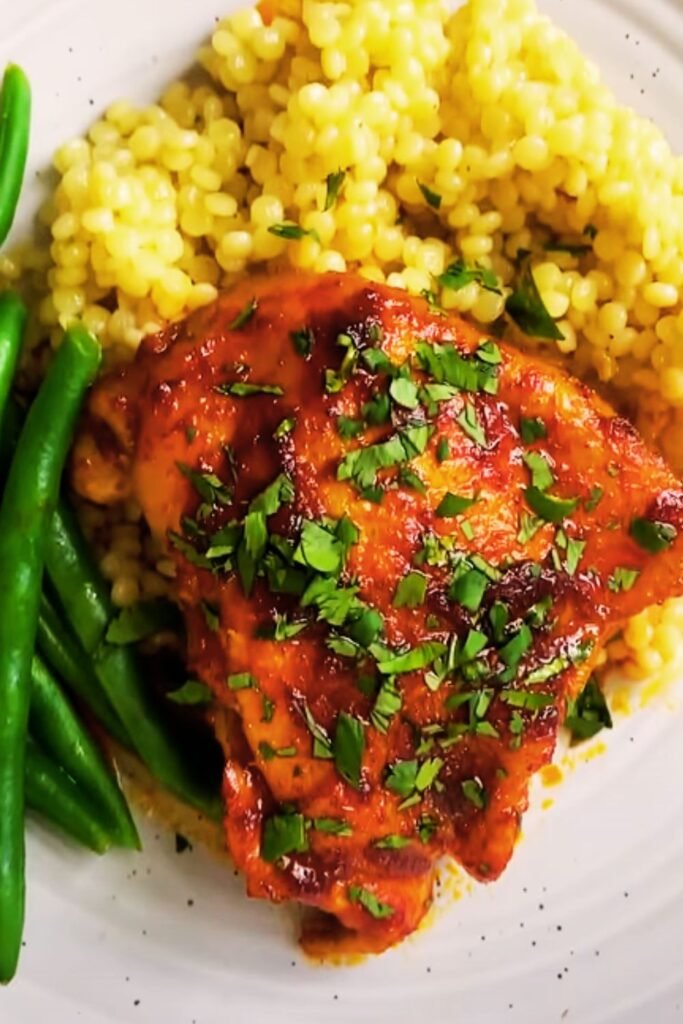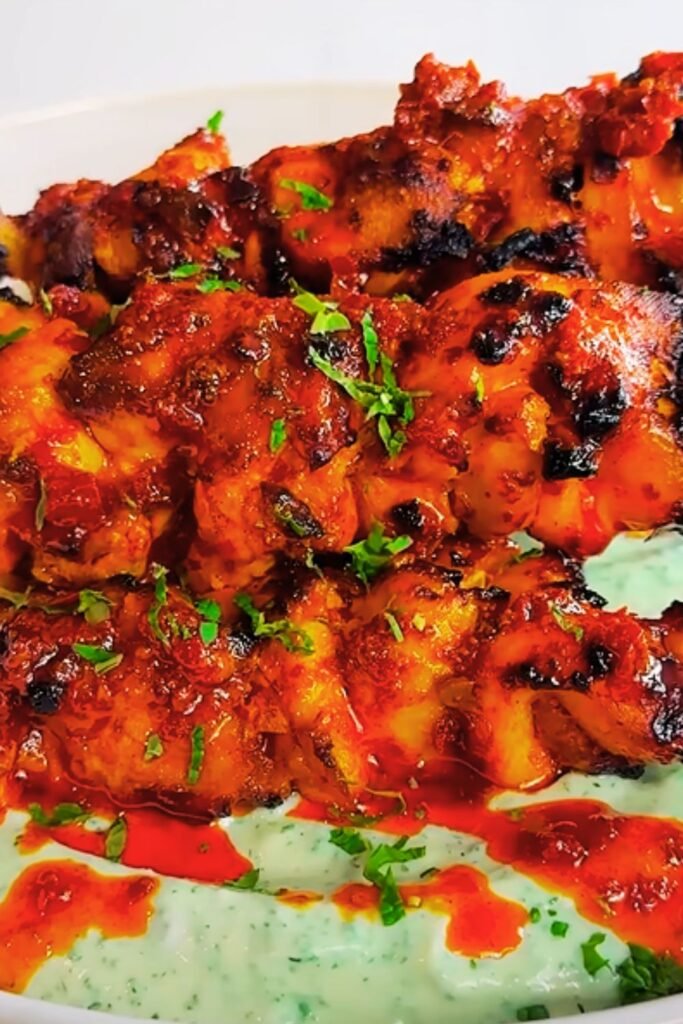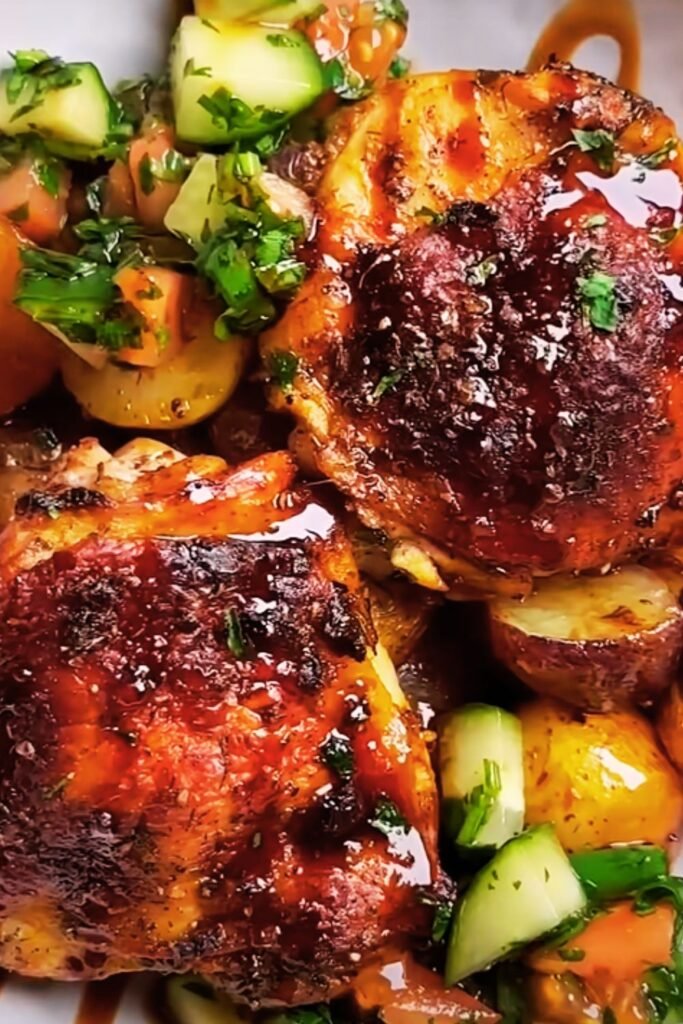There’s something magical about the way certain spices can transport you to faraway places with just one bite. That’s exactly what happened the first time I tried harissa chicken. The complex, smoky heat of this North African chili paste transformed an ordinary chicken dinner into something extraordinary, and I’ve been hooked ever since.
Today, I’m excited to share my perfected harissa chicken recipe that balances bold flavors with approachable techniques. Whether you’re already a fan of North African cuisine or just looking to spice up your dinner routine, this dish delivers incredible taste with minimal effort.
What is Harissa?
Before we dive into the recipe, let’s talk about the star ingredient:
Harissa : A hot chili paste that originated in Tunisia but is widely used throughout North Africa and the Middle East. Traditional harissa combines dried red chilies with garlic, olive oil, and spices like cumin, coriander, and caraway.
Rose Harissa : A variation that includes rose petals or rose water, adding a subtle floral note to balance the heat.
Harissa Paste vs. Powder : Paste is more common and what we’ll use in this recipe. It’s moister and more concentrated than the powder, which is simply dried and ground spices.
Spice Level : Traditional harissa can be quite hot, but commercial varieties range from mild to extremely spicy. I recommend starting with a milder version if you’re new to it.
Why You’ll Love This Recipe
- Perfect balance of spicy, sweet, and tangy flavors
- One-pan preparation makes cleanup a breeze
- Versatile serving options (works with rice, couscous, or as a sandwich filling)
- Make-ahead friendly for meal prep
- Impressive enough for guests but simple enough for weeknights
- Naturally gluten-free and dairy-free
Ingredients You’ll Need

For the Harissa Marinade:
- 1/4 cup harissa paste
- 3 tablespoons olive oil
- 2 tablespoons honey
- 4 garlic cloves, minced
- 1 tablespoon ground cumin
- 2 teaspoons ground coriander
- 1 teaspoon smoked paprika
- 1 teaspoon salt
- 1/2 teaspoon black pepper
- Juice and zest of 1 lemon
For the Chicken:
- 8 bone-in, skin-on chicken thighs (about 2 pounds)
- 1 large red onion, sliced into wedges
- 2 red bell peppers, sliced
- 1 lemon, sliced into rounds
- 1/4 cup fresh cilantro, chopped (for garnish)
- 1/4 cup fresh mint, chopped (for garnish)
- 1/4 cup pomegranate seeds (optional, for garnish)
Equipment Needed
While this recipe doesn’t require fancy equipment, you’ll need:
- Large mixing bowl
- Measuring cups and spoons
- Sharp knife and cutting board
- Large baking dish or sheet pan
- Aluminum foil (optional)
- Meat thermometer (recommended)
Step-by-Step Instructions
Preparing the Marinade
- In a large bowl, combine the harissa paste, olive oil, honey, minced garlic, cumin, coriander, smoked paprika, salt, pepper, lemon juice, and zest.
- Whisk thoroughly until all ingredients are well incorporated. The marinade should have a thick, paste-like consistency with a vibrant red color.
Marinating the Chicken
- Place the chicken thighs in the bowl with the marinade.
- Using your hands (wearing gloves is recommended), massage the marinade into the chicken, making sure to get under the skin where possible.
- Cover the bowl with plastic wrap and refrigerate for at least 2 hours, though overnight marinating will yield the best flavor.
Cooking the Chicken

- Preheat your oven to 425°F (220°C).
- Remove the marinated chicken from the refrigerator and let it sit at room temperature for about 20 minutes.
- Arrange the sliced red onion, bell peppers, and lemon rounds in a large baking dish or sheet pan.
- Place the marinated chicken thighs on top of the vegetables, skin side up.
- Pour any remaining marinade over the chicken and vegetables.
- Bake for 35-40 minutes, or until the chicken reaches an internal temperature of 165°F (74°C) and the skin is crispy and caramelized.
- If you want extra crispy skin, you can broil for the last 2-3 minutes, watching carefully to prevent burning.
- Remove from the oven and let rest for 5-10 minutes before serving.
Time-Saving Tips
- Use pre-minced garlic and pre-sliced vegetables to cut down on prep time.
- Marinate the chicken the night before or in the morning before work.
- Make extra marinade and freeze it for future use.
- Cook a double batch and use the leftovers for meal prep throughout the week.
Variations to Try
Grilled Harissa Chicken
Perfect for summer cookouts! Simply:
- Preheat your grill to medium-high heat.
- Oil the grates to prevent sticking.
- Grill the marinated chicken for 6-7 minutes per side, or until cooked through.
- Grill the vegetables in a grill basket alongside the chicken.
Vegetable Variations
You can customize the vegetables based on what’s in season or what you have on hand:
- Summer: Zucchini, eggplant, cherry tomatoes
- Fall: Butternut squash, brussels sprouts, carrots
- Year-round: Cauliflower, potatoes, chickpeas
Different Proteins
This marinade works beautifully with:
- Boneless, skinless chicken breasts (reduce cooking time to 25-30 minutes)
- Chicken drumsticks
- Firm white fish (reduce marinating time to 30 minutes)
- Tofu (extra-firm, pressed)
- Tempeh
Nutritional Profile
Here’s the approximate nutritional information per serving (based on two chicken thighs with vegetables):
| Nutrient | Amount | % Daily Value |
|---|---|---|
| Calories | 420 | – |
| Protein | 29g | 58% |
| Carbohydrates | 18g | 6% |
| Fat | 26g | 40% |
| Saturated Fat | 6g | 30% |
| Fiber | 3g | 12% |
| Sugar | 12g | 24% |
| Sodium | 680mg | 28% |
| Vitamin A | 2500IU | 50% |
| Vitamin C | 85mg | 95% |
| Calcium | 45mg | 4.5% |
| Iron | 2.2mg | 12% |
Note: Nutritional values are estimates and may vary based on specific ingredients used.
Serving Suggestions

This harissa chicken is incredibly versatile when it comes to serving options. Here are some of my favorite ways to enjoy it:
Grain Accompaniments
- Fluffy couscous (traditional or pearl)
- Fragrant basmati rice
- Hearty quinoa
- Warm pita bread
Fresh Sides
- Cooling cucumber yogurt sauce
- Simple green salad with lemon vinaigrette
- Roasted Mediterranean vegetables
- Herb-packed tabbouleh
Garnishes That Elevate
- Fresh herbs (cilantro, mint, parsley)
- Crunchy toasted pine nuts or almonds
- Tangy preserved lemon
- Sweet-tart pomegranate seeds
- Creamy crumbled feta cheese
Storage and Reheating
This harissa chicken keeps beautifully, making it perfect for meal prep or enjoying leftovers:
Refrigerator Storage
Store cooled leftovers in an airtight container in the refrigerator for up to 4 days.
Freezer Storage
For longer storage:
- Cool the chicken completely
- Separate chicken pieces from vegetables (vegetables tend to get mushy when frozen)
- Store in freezer-safe containers or bags
- Freeze for up to 3 months
- Thaw overnight in the refrigerator before reheating
Reheating Methods
For best results when reheating:
Oven Method (Preferred):
- Preheat oven to 350°F (175°C)
- Place chicken and vegetables in a baking dish
- Add a splash of chicken broth or water to prevent drying
- Cover with foil
- Heat for 15-20 minutes until warmed through
Microwave Method (Quick Option):
- Place portion on a microwave-safe plate
- Cover with a damp paper towel
- Heat in 30-second intervals until warmed through
- Note: Skin will lose its crispiness with this method
My Personal Journey with Harissa
I first discovered harissa during a cooking workshop five years ago. The instructor passed around a jar of this brick-red paste and encouraged us to take a small taste. The complex blend of chilies, garlic, and spices immediately captivated me – spicy yet nuanced, with layers of flavor that went far beyond mere heat.
Since then, I’ve experimented with countless applications for harissa in my kitchen. I’ve stirred it into soups, slathered it on vegetables before roasting, and even mixed it with mayonnaise for a spicy sandwich spread. But this chicken recipe remains my favorite way to showcase its magic.
What I love most about cooking with harissa is how it instantly adds depth to a dish without requiring dozens of individual spices. It’s the perfect shortcut to creating food with character and complexity.
Frequently Asked Questions
Can I use boneless skinless chicken breasts instead of thighs? Yes, absolutely! Boneless skinless chicken breasts will work, but they tend to dry out more easily than thighs. I recommend reducing the cooking time to 20-25 minutes and checking the internal temperature to ensure they don’t overcook. You might also want to increase the olive oil in the marinade slightly to compensate for the lack of skin.
How spicy is this dish? The spice level depends entirely on the harissa paste you use. Commercial brands range from mild to very hot. If you’re sensitive to spice, start with a mild harissa and use less than the recipe calls for. You can always add more heat with red pepper flakes at the table.
Can I make my own harissa paste? Absolutely! Homemade harissa is delicious and allows you to control the heat level. Here’s a simple recipe:
- Soak 8 dried chilies in hot water for 30 minutes, then remove seeds
- Toast 1 tsp each of cumin, coriander, and caraway seeds
- Blend rehydrated chilies with toasted spices, 3 garlic cloves, 1/2 tsp salt, and olive oil until smooth
Is harissa the same as sriracha or other hot sauces? No, harissa has a distinct flavor profile. While sriracha is primarily chilies, vinegar, and garlic, harissa includes a complex blend of spices like cumin, coriander, and caraway. The texture is also different – harissa is typically a thicker paste rather than a sauce.
What can I substitute if I can’t find harissa paste? In a pinch, you can substitute a mixture of tomato paste, cayenne pepper, minced garlic, cumin, coriander, and olive oil. It won’t have the exact same flavor profile, but it will create a similar effect in the dish.
Can this recipe be made ahead for a dinner party? Definitely! In fact, marinating the chicken overnight improves the flavor. You can also prepare the dish completely up to the baking step, refrigerate, and then bake just before serving. Allow an extra 5-10 minutes of cooking time if you’re starting from a refrigerated state.
How do I prevent the chicken skin from burning? If you notice the skin getting too dark before the chicken is fully cooked, simply cover the dish loosely with aluminum foil for the remainder of the cooking time. This will protect the skin while allowing the chicken to finish cooking.
Is this recipe keto-friendly? The recipe contains honey, which isn’t strictly keto. However, you can make it keto-friendly by substituting the honey with a keto-approved sweetener like monk fruit or erythritol. The rest of the ingredients fit well within a keto eating plan.
Why This Recipe Works
As I’ve refined this recipe over the years, I’ve discovered a few key principles that make it foolproof:
- The Marinade Trifecta: The combination of acid (lemon), fat (olive oil), and heat (harissa) creates perfect flavor penetration.
- Bone-in, Skin-on Thighs: Using this cut of chicken provides natural protection against overcooking while the skin renders and crisps beautifully.
- The Vegetable Bed: Placing the chicken on top of the vegetables allows them to cook in the flavorful drippings while simultaneously keeping the chicken elevated for even heat circulation.
- Temperature Control: Starting with room temperature chicken ensures even cooking from the outside in.
- The Rest Period: Allowing the chicken to rest after cooking keeps it juicy and gives the flavors time to settle.
This isn’t just a recipe – it’s a technique that you can adapt and make your own. Once you master the basics, you’ll find yourself reaching for that jar of harissa to transform all sorts of everyday ingredients into extraordinary meals.
So go ahead, bring a taste of North Africa to your dinner table tonight. I guarantee this harissa chicken will earn a permanent spot in your recipe collection!